Inimitable style
The manor house, in deep seclusion,
screened by a hill from storm's intrusion,
looked on a river: far away
before it was the golden play
of light that flowering fields reflected:
villages flickered far and near,
and cattle roamed the plain, and here
a park, enormous and neglected,
spread out its shadow all around --
the pensive Dryads' hiding-ground.
The chateau was of a construction
befitting such a noble pile:
it stood, defiant of destruction
in sensible old-fashioned style.
A. S. Pushkin. Eugene Onegin (tr.Ch.Johnston)
Not only is one's home one's castle, it is one's mirror as well. A distinguishing feature of Russian manors (usadba) is their unparalleled style. The key priority was to provide a comfortable life style in a city, yet at the same time owners were strongly committed to developing their manors in style to fit for luxurious living and entertaining their guests. Even members of the Tsar Family used to pay occasional visits to their courtier's manors.
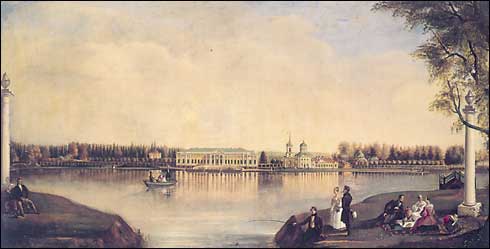
| N. Podklyuchnikov. Kuskovo. View on the manor house from the
pond. 1839 |
Magnificent manor estates of the nobility with stunning palaces and beautifully landscaped parks served as the venue of balls, concerts and theater performances.
While men were making destinies of Russia, women were promenading in parks discussing equally important topics such as French attires, arts and new premieres in metropolitan theaters. Shadowy alleys, pavilions and grottos served as meeting places for young ladies and gentlemen, heirs and heiresses of the manors' owners. There were a lot of manor houses suitable only as summer residences, yet with every possible urban comfort - the ancestors of today's dachas. However, the scale and splendor of the Russian nobility's visits to country estates deserve a separate description.
Recreational mansions located close to Moscow served as a place for joyous outings or "diversions" as they used to call them in the past, at the same time being at the hub of the national culture development. Owners of opulent manors, such as Ostankino, often established private theaters. The world's best architects designed palatial houses of those estates. Their galleries and halls abounded with beautiful works of art.
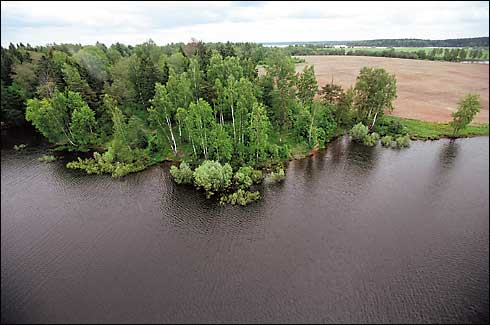
| Ozerninskoye Water Reservoir |
Landscape architecture of Russian manors was developing along the European lines, yet the enigmatic Russian soul was making a creative contribution of its own. The combination of primness and orderliness of an English park with Russian confusion produced a staggering effect upon contemporaries. There were no sharp boundaries between a Russian park and the surrounding terrain. The ensemble created by the nature itself remained undisrupted by man's ideas; it was only accurately complemented with various distinctive elements to add zest, such as a pond, a grotto, a pavilion or a flowerbed.
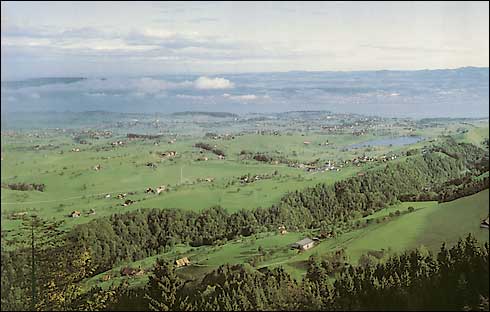
| Switzerland. Foothills of the Alps |
A walk around a manor
"If you choose to take a rest from metropolitan hustle and bustle, my dear sir, please, come to our place, where quiet and peace reign. Let's gather a genial company, listen to a touring Gypsy choir, indulge in luxury enjoying a languor induced by sweet wine, and watch smooth movements of our young ladies". In such manner, a well-pleased landlord residing in some manor not far away from Moscow and partaking in early autumn fruits could begin his letter to a friend exhausted by Moscow life with its fuss and scheming.
Having made up his mind, the latter gets into his carriage and hastens to the suburb hoping to catch the last warm days of early autumn. Meadows, fields and woods so delightful for the eye of a city-dweller are enveloping him, and he feels that the author of Woe from Wit was right: "Down to the country, to the aunt's, to God-forsaken place, to Saratov…" - Why have I lost so much time?
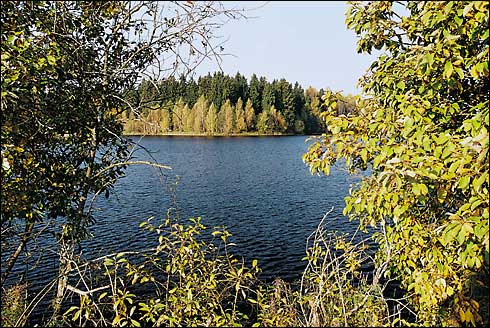
| Ozerninskoye Water Reservoir |
Having turned off the road, our visitor directs his steps into magical woods, going deeper and deeper. And soon dusk overtakes him at the entrance pillars guarding the drive-up that leads through the main gates to the court of honor of the main house. Court of honor, curdoner in Russian, cour d'honneur. Ah, French, French, what a lot of new words has appeared in Russian thanks to the French. They would call this court "cour d'honneur" in Paris, - muses our romantic character.
Standing at the porch of the main house, our city-dweller is peacefully watching first some servants and then the landlord himself accompanied by his young wife come outside to greet him. This is the facade of the main house, - our dreamer thinks. And what does the opposite side look like, the one facing the park?
Having welcomed his guest, the host invites him in, but our character takes an active interest in everything around him. - Please show me over your estate, he asks. Well, while the dinner is being prepared, I have much to show you, answers the landlord. "Here you can see the winged main house, and right behind it is a formal French park. It is there where we celebrate special events, give balls, and relax. I have neatly cut the grass and pruned the shrubs, and look at all these statues! There are plenty of them, aren't there? They have been brought right from Naples on my order, says the host, bragging a little. Here is an alley, I call it Champs-Elysees.
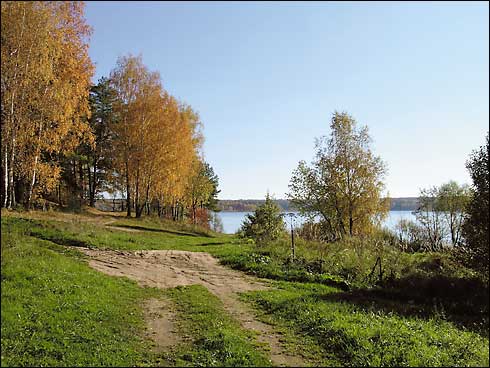
In the distance our romantic man notices a cozy pavilion where a young girl in a white dress is reading a book. But the host is already pulling him forward. - Come along now, come along. In addition to the French park, I have got an English one as well!
Everything here looks astonishing to our character. The English park has a rare and amazing quality - it somehow associates with the attire of a prime lady from Misty Albion, but at the same time something makes one think about the disorderly Russian spirit. The wood has remained untouched, but footbridges across the pond and the grotto, man-made pseudo-ancient ruins and alleys imply the close presence of human beings. Having coming back to the main house, our character notices in the distance an outbuilding of a kind, from where he seems to hear a neigh. What's this, he asks. Indeed, I breed horses, haven't you known? We supply them to the Imperial Court, answers the landlord with a pleased smile.

Suddenly our gentleman hears some bells chiming. The evening service in the manor church is about to start. Well, it is time for dinner, and then for sleep, come along, I'll introduce you to my niece! - somewhat enigmatically declares the host. And the friends go inside. A big reception is scheduled for the next morning, and the manor is busily preparing to welcome quests.
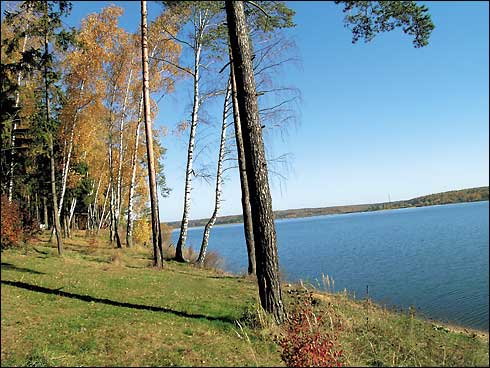
Moscow region manors
The history of Moscow region manors (usadba) has roots quite deep in time. The modern history widely uses such terms as "peasant usadba", "artisan usadba", "cloistral usadba", etc, but of course all these early-time "usadbas" have nothing in common with 18-19th century manor estates. A pre-manor of a sort can be found in the 16-century suburban estates, which used to be given as an appanage and included a small farmstead.
The same 16th century saw a start of tradition to build private stone churches on estates - the first step towards the future ornamenting of manor ensembles. Contemporaneously with the beginning of the church building trend we see the segregation of first residential estates of a kind - Grand Duke's (and later Tsar's) suburban hereditary estates - out of the mass of ordinary farmsteads. The most demonstrative example is the Kolomenskoye hereditary estate, which is presently situated within the city limits of Moscow.
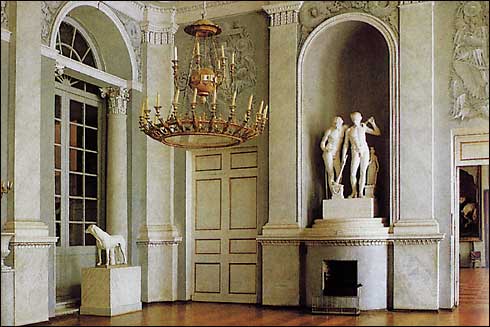
| Details of interior design of the palace |
General architectural and interior outlook of Russian manors was formed in the early 18th century, amidst the development of high society culture. By the mid-century a number of important manors had already been in place. By the second half of the 18th century the manors turned into full-fledged cultural and artistic complexes. The heyday years of Moscow suburban manors fall at the late 18th - early 19th century.
Enlightenment traditions characteristic of that period inculcated in the society the idea of creation of a new beautiful and happy world, which found its reflection in particular in Russian manor art. The focal point of any manor complex was the main house, to which led a long alley from a public road. In some cases the alley was adorned with a ceremonial entry arch, like, for example, in Arkhangelskoye and Grebnevo manors. The manor house was often crowned with a belvedere (Nikolskoye-Gagarino, Valuevo) or a dome (Pekhra-Yakovlevskoye). Many houses resemble a museum for their art and sculpture collections, furniture and interior details (like, for example, Ostafyevo or Kuskovo).
But a manor included not only the main house, but also comprehensive infrastructure carefully created for comfortable and carefree life. An indispensable attribute of a manor estate was a stable yard or stables. Even if the owners were indifferent to hunting, they needed horses to get to the town or to their neighbors'. Along with the stable yard any manor estate maintained a coach-house. Besides, a manor complex included a number of household outbuildings, such as millhouses, works, an estate manager's house, an office building and a water tower. Some manors featured a theater building (Olgovo, Grebnevo, Pekhra-Yakovlevskoye). Landlords used to take a special pride in their parks and always kept up with park design fashion. Some preferred French formal parks, others laid out the English landscape ones; there were also a few manor estates that combined formal parks with the landscape ones. Pavilions were built, shadowy and sunlit alleys were laid. Some owners organized small "drapery undertakings", like, for example, a weaving mill in Olgovo or a broadcloth factory in Ostafievo.
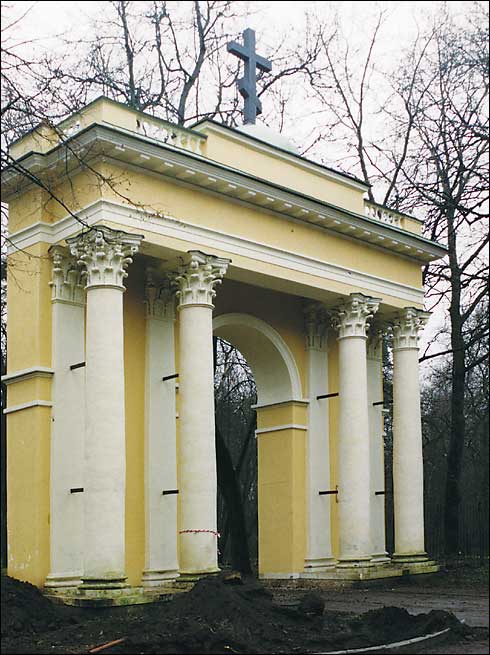
Another indispensable attribute of any large manor estate was a church, and every landlord paid special attention to its ornamentation. The house of a local priest often sat on the site as well. Ancient churches were often modernized in accordance with contemporary tastes and furnished with new elements, acquiring new interior and exterior outlooks.
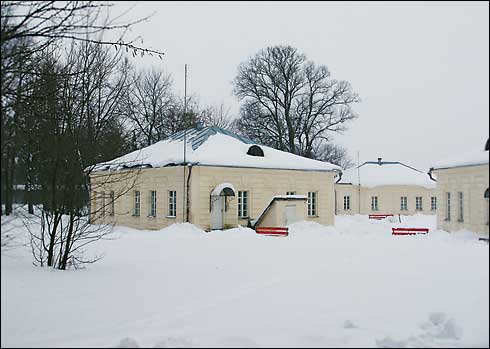
| Restored wings of Nickolskoye-Gagarino estate |
A manor house was inseparable from local natural environment, from the surrounding forests that offered excellent hunting, fishing, mushrooming and berries gathering. Indeed, hunting occupied a special place in the life of landlords, and a first-class stable yard or kennel were no less important than gorgeous architecture of the manor complex or excellent interior design of the main house. Each landlord has a little something to be proud of - first-rate dogs, cascade ponds with crucian carps, wine-cellar or, for example, the best blacksmith in the district. The manors inspired poets, artists, and musicians; manor life events underlie the plots of numerous literary works.
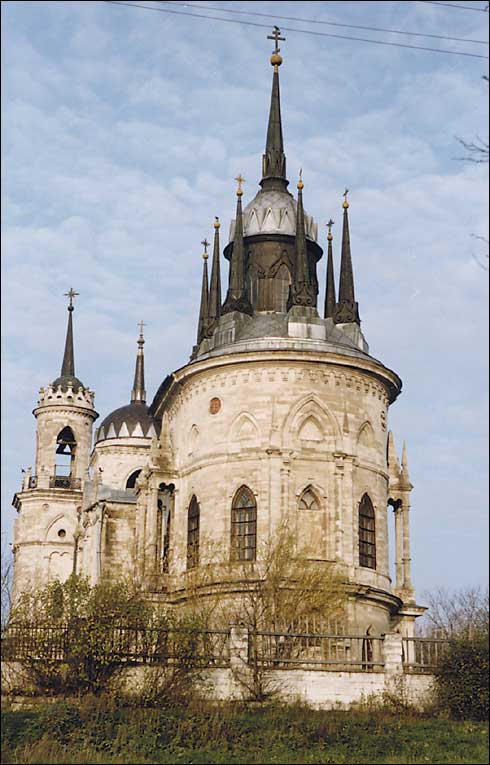
| Vladimirskaya Church in Bykovo (1788) |
Ruza manors
Ruza was the western stronghold of the Principality of Muscovy. The earliest record mentioning the town is the testament of Grand Duke of Moscow Ivan Kalita of 1328. All significant events in the Russian history have involved the area. Ruza played an important part in the integration of all Russian lands under the rule of Moscow. It survived Polish and Lithuanian invasion in 1618, French troops attack on Moscow in 1812, fascist aggressors intrusions during the World War II. Enemies have never conquered the Ruza Kremlin, which existed until the 18th century.
In the 20th century Ruza district became a center of major resort and recreational area of the Moscow Region. Its picturesque landscapes made it a perfect holiday destination and prompted the development of numerous health resorts and holiday centers. Even now the most promising line of the district development lies in that field, as the main wealth of the land is the perfectly clean environment.
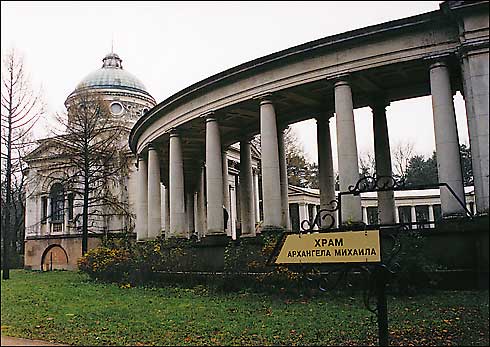
Writers, composers and actors chose to establish their creative work centers here . Amidst beautiful Ruza landscapes worked many prominent figures of the 20th century - writers K. Paustovsky, A. Fadeev, A. Gaidar, M. Svetlov, A. Tolstoy, composers T. Khrennikov, A. Khachaturyan, Y. Frenkel, A. Pakhmutova. Along with holiday facilities, Ruza District is rich in health resorts and treatment centers, such as the health center in Dorokhovo that uses local spring waters for curative and restorative procedures and the former health resort of the Central Committee of the CPSU that now belongs to the Presidential Administration.
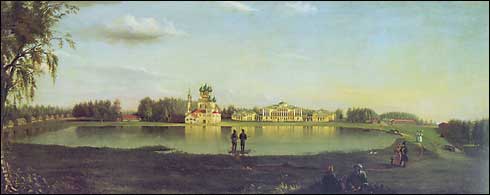
| N. Podklyuchnikov. Ostankino. Overall view of the mansion house |
From the late 17th to 19th century Ruza was a preferred location for noble families to settle down and build palatial hereditary estate ensembles. Among them are Arkhangelskoye (the manor of O.I. Bove, a famous Russian architect), Annino (patrimony of the Miloslavskys boyars), Bogorodskoye (owned by Count D.A. Guryev), Vasilievskoye (hereditary estate of I.A. Yakovlev, the father of Alexander Gertsen; in 1845 it passed to Princes Shcherbatovs), Volynshchina-Poluektovo (initially the patrimony of the Volynskys boyars; afterwards belonged to Count V.N. Dolgorukiy-Krymsky), the pearl of the Ruza District - Nikolskoye-Gagarino built by Prince S.V. Gagarin, and Pokrovskoye-Sheremetyevo where the poet F.I. Tyutchev spent his childhood.

| Front facade of the palace in Bykovo |
Arkhangelskoye Manor
Arkhangelskoye Manor sitting on the bank of the Tarusa River has a rich history. The village came in possession of princes Trubetskys in 1710. In 1813, the last male owner belonging to the family was killed in the battle of Leipzig, when Europe fought to liberate itself from Napoleon troops. His widow Avdotya Semenovna inherited the village, and in 1816 married the renowned architect Osip Ivanovich Bove, who renovated the manor into a stunning shape.
Osip Ivanovich Bove restored the Moscow Kremiln after it was burned by Napoleon. In 1813, he joined the Moscow Development Committee; he initiated the construction of the Red Square shopping arcade, the Alexandrovsky Park grotto, Bolshoi and Malyi theater buildings, the Triumphal Arch.
O.I. Bove paid great attention to Arkhangelskoye Manor development. A church constructed in the manor in 1822, the empire brick building with white stone details, is one of the best creations of the architect, a prominent architectural monument of the time.
Annino Manor
Annino is one of the oldest Russian villages; its history is closely connected with the strengthening of the Principality of Muscovy in the 12th -13th centuries, when Russian rulers strived to establish new trade routes. In 1368, it saw the grave battle between Moscow warriors and joined Tver and Lithuanian forces that was subsequently named "the Slaughter". Tver and Lithuanian invaders failed to reach their goal - to conquer Moscow. In the 16th century, these lands belonged to Great Dukes of Moscow. The modern name of the village Annino (Anna's Manor) springs from the name of Ivan the Terrible's wife Tsarina Anna, who was exiled to the area. In 1656, Tsar Alexei Mikhailovich transferred the village into the ownership of the ancient boyar family Miloslavskys, under whose control it was remaining until the 18th century.
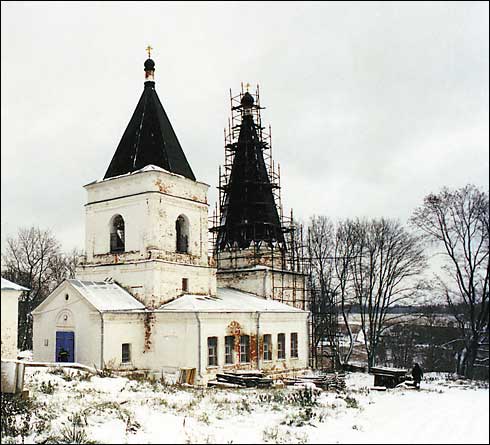
| Church of the Holy Mother Icon "The Sign" and
an estate in the village of Annino |
The manor house in Annino was built in the 70s of the 18th century; at that time the village was owned by A.N. Kheraskov. Znamenskaya church and the manor formed a perfect architectural ensemble.
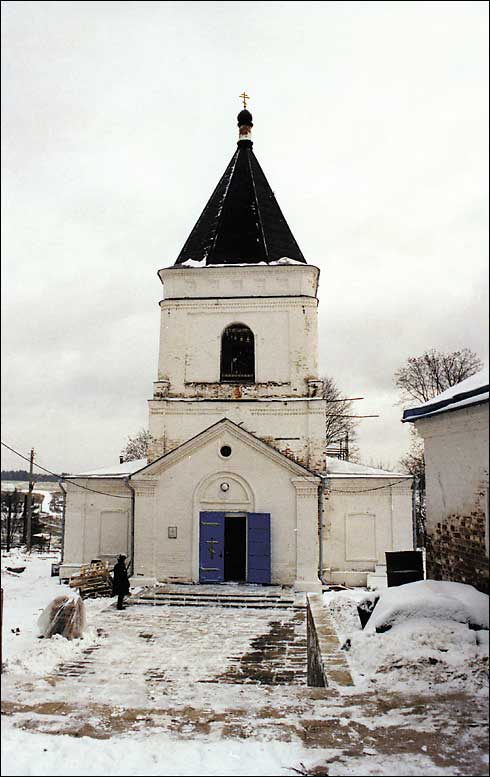
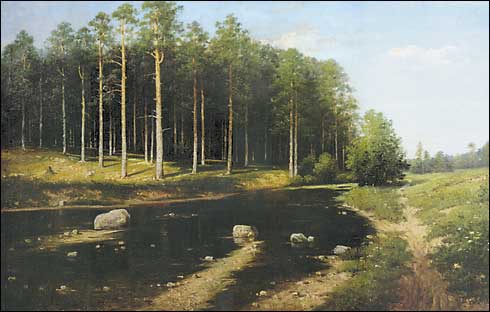
| V. Polenov. Pine Forest on the River Bank |
The manor house with an adjacent park and the church has survived until present time. The two-storied timber floor brick building with the facade adorned by panels and dummy joints closely resembles an urban residential development. The court of honor, the open side of which once revealed a view of the church on the opposite side, is hemmed with the double line of ancient limes. The opposite side of the house faces a small desolate garden park featuring a group of mighty larches and man-made ponds. Blue firs are planted around the park periphery. The park borders on the village on the one side and on a vast household zone on the opposite side.
Pokrovskoye-Sheremetyevo Manor
Pokrovskoye-Sheremetyevo Manor is located on a high hill overlooking the Ozerna River. In 1678, it became the patrimony of the boyar Serguei Abramovich Lopukhin, and, in 1705, his widow Marya took the control over the village in her hands. From 1716 until 1762 the village belonged to Vladimir Petrovich Sheremetyev (of the non-palatine branch of the family).
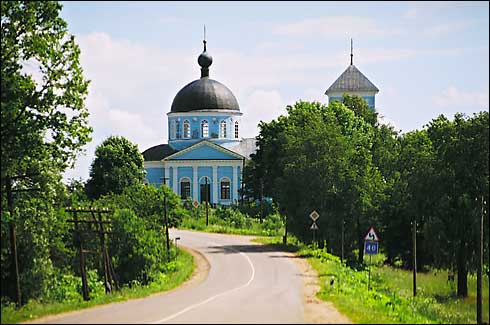
| Pokrovskaya Church, Pokrovskogo-Sheremetievo village |
It was in the patrimonial manor Pokrovskoye-Sheremetyevo owned by Nadezhda Nikolaevna Sheremetyeva (nee Tyutcheva) where the famous poet Fyodor Ivanovich Tyutchev spent his childhood.
The center of the village is dominated by the stone Holy Protection of the Mother of God Church built to celebrate the victory of the Russian arms in the War of 1812.
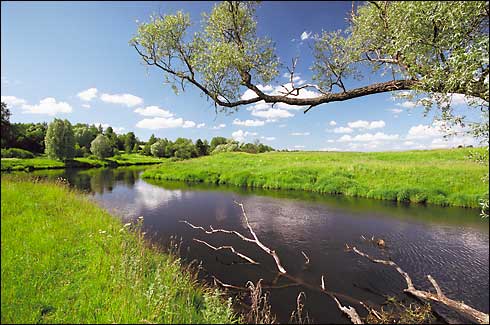
Bogorodskoye Manor
First records mentioning Bogorodskoye village are dated by the 17th century. Bogorodskoye manor belonged to the rich okolnichiy Alexander Sevastyanovich Khitrovo, whose daughter Anna Fyodorovna married Pavel Ivanovich Yaguzhinsky, a close friend and assistant of Peter the Great. However, Anna Fyodorovna went out of her mind and finished her days in a convent. The Bogorodskoye manor devolved to her daughter Ekaterina Pavlovna. In the 18th century, the manor changed its owners several times, passing from one noble family to another, including the Lopukhins, the Golovins and the Gurievs.
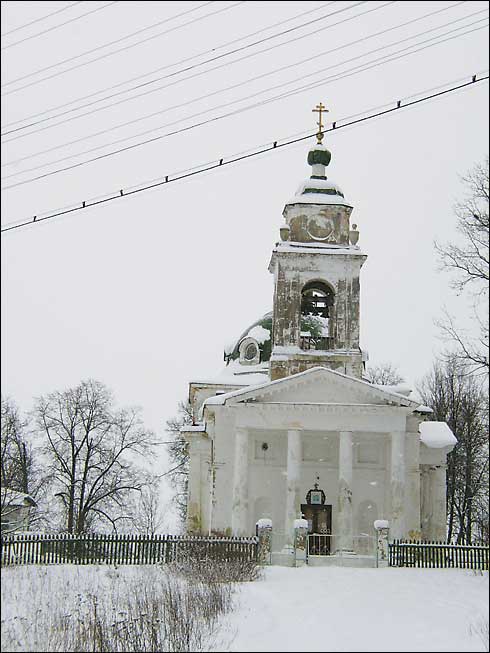
| Church of the Protecting Veil of the Holy Mother of God, Bogorodskoye
village |
Bogorodskoye manor ensemble reached its heyday in the first quarter of the 19th century when the village passed into the ownership of Dmitry Alexandrovich Guriev, Minister of Finance at the Court of Alexander I. The whole estate complex is the graphic evidence of the delicate and refined taste of its owner.
The two-storied stone house was built in the late Classical style. Together with two one-storied side wings it formed a court of honor, the open northern side of which offered a view of the road to Moscow. To the east of the house between the palace and a park terrace there used to be a marble fountain of considerable artistic value. Splendid landscape park descended from the house to a man-made pond with two islets. The park was adorned with numerous pavilions, a grotto crowned by a marble column brought from Italy, and four marble statues.
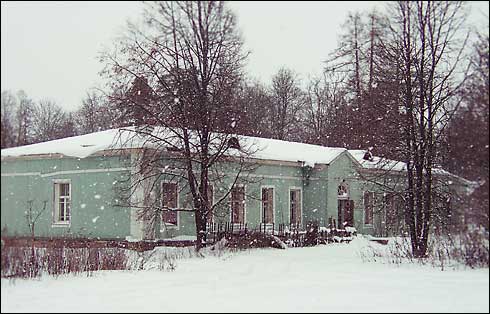
| Left wing of Bogorodskoye-Voronino estate |
Vasilievskoye Manor
The village Vasilievskoye belonged to a monastery from the 15th until the late 17th century. In 1498, it was awarded to Moscow Simonov Monastery by a letter of grant of Ruza prince Ioann Borisovich, and in 1626 it was transferred into the ownership of Novo-Spassky Monastery by a decree of Tsar Mikhail Fyodorovich Romanov.
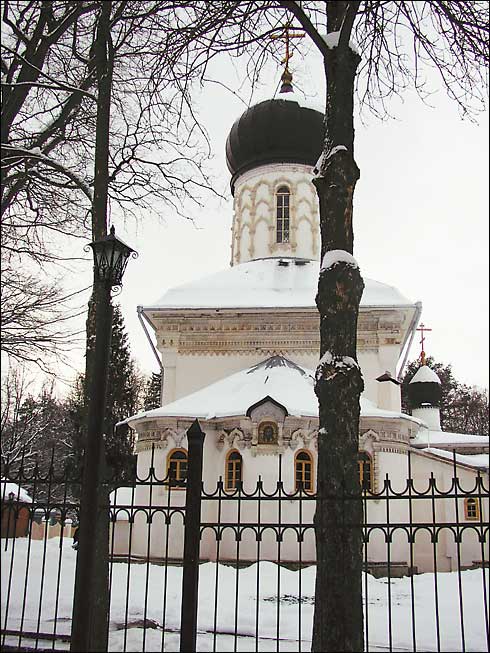
| Church and shrine of the Holy Martyr and Healer Panteleimon,
Vasilievskoe village |
The "monastic" period in the history of the village came to end in 1673. From that time Vasilievskoye passed through the hands of many famous noble families. The first ones were the Matveyevs, but Tsar Fyodor Alexeevich took it away from them to present to his family member Duma clark and boyar Semion Zaborovsky. After his death his widow Fedora Stepanovna Zaborovskaya sold Vasilievskoye estate at 6,000 rubles to the prominent politician and diplomat E.I. Ukraintsev. After his death Peter the Great took Vasilievskoye away from his heirs and presented the village to Gavriil Ivanovich Golovkin, having written with his own hand: "this day November 11, 1708 we have granted to Mr. Golovkin the village of Vasilievskoye left after the deceased dyack Ukraintsev, with all dwellings and wastelands and all the belongings. Peter." Golovkin, Peter the Great's ally, was a member of the Supreme Privy Council at the time of Ekaterina and First Cabinet-Minister in the reign of Anna Ioannovna. In 1822, Vasilievskoye passed to I.A. Yakovlev, the father of the writer Alexander Ivanovich Gertsen. Vasilievskoe used to be the favorite Moscow suburban estate of the latter. In 1845 the manor was sold to Major General of Infantry Prince Nikolai Grigorievich Shcherbatov, a hero of the battle of Borodino. After that the village repeatedly changed hands through inheritance and purchase. Among its owners were the Cherkasskys, the Rimsky-Korsakovs and other well-known Russian families.
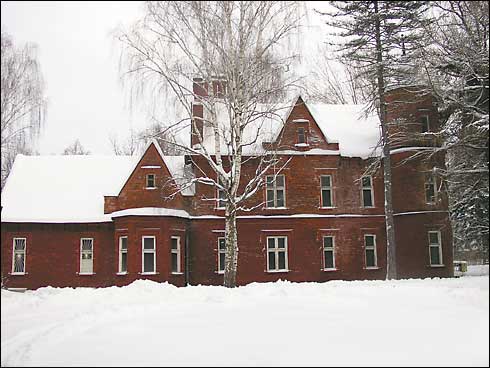
In the second half of the 19th century, Prince Alexander Grigorievich Shcherbakov, who owned Vasilievskoye at that time, established in the estate the first stud-farms specializing in Arabian horses breeding, which subsequently supplied horses to the Imperial Court.
In 1881, on the right bank of the Moscow River, A.G. Shcherbatov built a castle in the eclectic style with a "romantic bent", which can be seen in Vasilievskoye. A dungeon unites the main part of the building and its side wing. Chimneys rise above its V-roof in the best old English tradition. In front of the castle there is an English-style lawn with brick-pawed paths. Hothouses featured rare flowers and trees brought from India, Syria, and Java; the park amazed visitors with a great variety of incredible plants. Tamed chamoises and roes grazed on the lawns. The Prince took a great interest in his zoo with exotic animals, and the princess loved hunting and adored dogs.
In 1919, a Soviet decree turned the former Shcherbakovs' manor house in the second holiday house in the country, Vasilievskoye. Today the castle hosts A.I. Gertsen museum exposition.
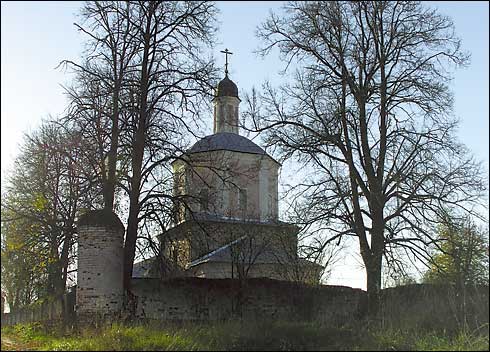
| Panteleimonovskaya Church, Vasilievskoye village |
Nikolskoye-Gagarino Manor, Nikolskoye village
The architectural ensemble of Nikolskoye-Gagarino manor was formed in the 70s of the 18th century at the time of Count S.V. Gagarin, who invited the famous architect I.E. Starov to participate in the development project.
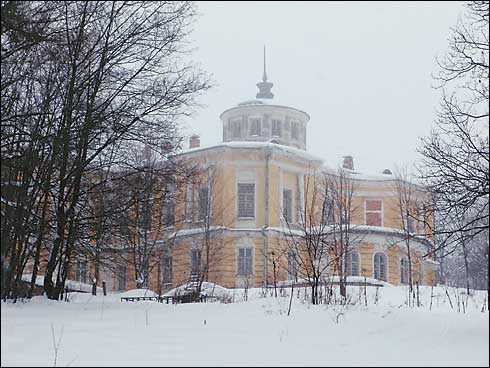
| Two-story main house with a pinnacle |
Well-preserved main house is located along the axis of the main alley, which leads to the manor. Its solemn, stately, even severe architectural design is emphasized by low monumental belvedere. The central part is sunken and highlighted by a broad staircase and a high attic. The court of honor is formed by curving stonewalls connecting the house with its side wings. Built into the walls are magnificent ornate gates with wide archways.
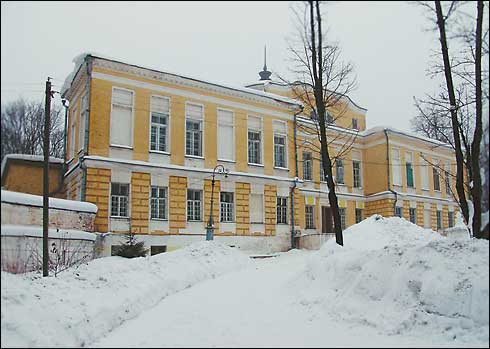
| Front facade of the main house of the palace |
In 1981, Nikolskoye-Gagarino manor served as a set for the movie "Flying Hussar Squadron" about Denis Davydov, a hero of the 1812 Patriotic War.
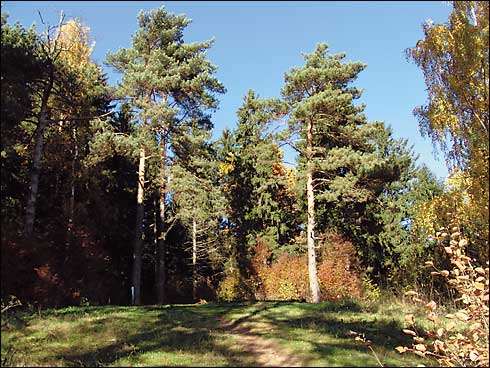
Volynshchina-Poluektovo Manor
These lands were granted to Poluekt Borisovich, a grandson of Grand Duke Dmitry Mikhailovich Bobrock-Volynsky, in the 15th century. It was after him that the estate Volynshchina-Poluektovo got its name. In 1743, Anastasiya Volynskaya married Mikhail Vasilievich Dolgoruky and got Volynshchina as a part of her dowry. The Dolgorukovs, one of the noblest families in Russia, are direct descendants of the Ryuriks. Moscow suburban estate of the Dolgorukovs was built in the 70s of the 18th century. The manor house sits on a beautiful site, on a low hill descending to the Ozerna River. It was surrounded by a modest-sized landscape park, which smoothly melted into a farm zone. The court of honor has an unusual circle-wise design. The centricity of the layout is emphasized by a round flowerbed, which at that time had a fountain in the center. Peculiarly, that court is formed by the buildings themselves - such layout is more common for urban residences.
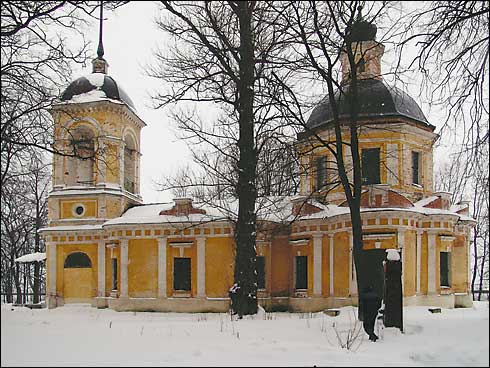
| Three Saints Church. 1780 |
The manor house sits on a plinth; on both sides of the loggia there are staircases leading to entrance doors. The fronton is decorated with the Dolgorukovs' coat of arms circled with molded garlands. There used to be a cabinet of curiosities featuring collections brought by the Dolgorukovs from military campaigns. The exterior of the manor house conforms to principles of the classic style, but at the same time one can notice certain elements of the baroque and rococo.
The most well-preserved part of the park ensemble is the main alley. It runs to the court of honor itself and serves as the main entry way of Volynshchina estate.
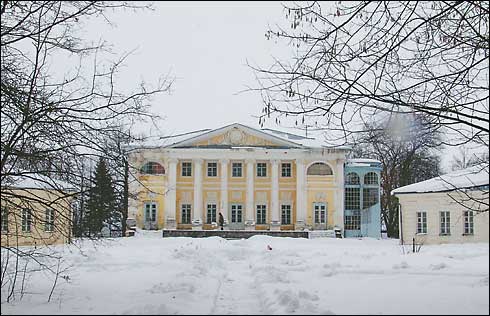
| View on the main house from the front court (1770s) |
|















